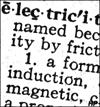October 2001
A Homeowner's Glossary of Electrical Terms
For most of us, "Where do I plug it in?" is all we need - or want - to know about our household electrical system.
 However, electricity is much in the news today, as homeowners are called on to understand deregulation, choose local service providers and ponder periodic energy crises. And, every so often, almost all of us have to call an electrician to fix a problem or upgrade our home's service.
However, electricity is much in the news today, as homeowners are called on to understand deregulation, choose local service providers and ponder periodic energy crises. And, every so often, almost all of us have to call an electrician to fix a problem or upgrade our home's service.
So we all need to be better informed, at least in basic terms, about a commodity we too often take for granted. The following glossary, brought to you by the Copper Development Association, can "empower" even the most electrically challenged of us and help us keep up with "current" events.
Alternating Current (ac) - A more efficient method of transmitting electricity by rapidly alternating, or reversing, the power flow in a circuit. By alternating the current, power can be sent over longer distances at higher voltages with less energy loss than with direct current (dc).
Amperage - The amount or rate of flow of electric current measured in amperes (amps). Like water in a pipe, current flows through wiring circuits in greater or lesser amounts depending on the power needed. Components of a home wiring system, such as circuit breakers, fuses, wall switches, outlets, etc., are rated according to their amperage capacity. The amperage of an appliance is measured by the number of amps it requires to operate properly.
Circuit - A circular path traveled by an electric current, emanating from and returning to a single source. In a home, each wiring circuit begins at the power source (usually a service panel), then, via the black wire, leads to outlets, switches, fixtures or plugged-in appliances before ultimately returning to the source, via the white wire.
Direct Current (dc) - Electrical power that flows in only one direction. Batteries are examples of devices that produce direct current.
Frequency - The number of times that alternating current reverses polarity, or direction, usually expressed in hertz (cycles per second). In the USA, most electricity is generated at 60 Hz (hertz).
Kilowatt-hours (kWh) - A measure of an amount of energy. Consumers are billed for electricity in kilowatt-hour increments. Each kilowatt-hour is a measure of energy equivalent to ten 100- watt light bulbs burning for one hour.
Short Circuit - Typically, a "short" occurs when a current-carrying wire unintentionally contacts another conductive element - another electric wire, a metal object, or even your body. This can create a dangerous situation, as the diverted flow of electricity naturally seeks to return to its source, or to the ground, by any accessible conductive route.
Switch - A device that controls the flow of current in an electrical circuit. When a switch is open, the circuit is broken and the flow of current is cut off. Closing the switch completes the circuit and allows the current to flow.
Voltage - A measurement in volts (V) of the "pressure" of electric power. Virtually all homes connected to a utility power grid in this country distribute alternating current through 120- or 240-volt circuits.
Learn more information on these applications in our Electrical and Telecommunications sections.
